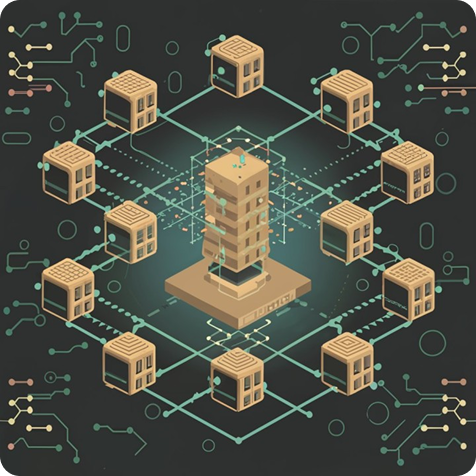Building a Layer 1 Blockchain: Architecture, Tools, and Step-by-Step Guide for Blockchain development
Creating a Layer 1 blockchain by forking Binance Smart Chain (BSC) involves several steps, including setting up the development environment, modifying the source code, deploying the network, and maintaining it

Setting Up the Development Environment installation
Install Go (Golang) ,Node.js and NPM
- BSC is written in Go, so you'll need to install Go on your machine.
- Download and install from the official site:https://golang.org/dl/.
- Install Node.js and NPM for managing JavaScript dependencies.
- Download and install from the official site:https://nodejs.org/.
Clone the BSC Repository and Modifying the Source Code
- Clone the official BSC GitHub repository git clone https://github.com/binance-chain/bsc
- Modify the params/config.go file to customize chain parameters like ChainID, Block Time, Gas Limit, and Initial Supply.
- Update Genesis File as per your configuaration.
1. Customize the genesis.json file in the cmd/geth directory. This file initializes your blockchain with custom genesis block parameters.
2. Configure the pre-funded accounts (wallets ), initial token distribution, and other parameters.
- Update the Consensus Mechanism as per your business model.
1. If you want to customize the consensus algorithm, you can modify the consensus related code in the consensus package.
2. For BSC, which uses a modified version of Ethereum's Proof of Staked Authority (PoSA), you may want to customize it based on your network's needs.
- Compile the Source Code and Build the BSC node from the modified source code.
- Run the BSC Node via Initialising the blockchain with your custom genesis file.
- ./build/bin/geth --datadir ./node init genesis.json
Setting Up the Network
Deploy Multiple Nodes
- Deploy multiple nodes on different machines or cloud servers to create a decentralized network.
- Each node should be initialised with the same genesis.json and connected using the --bootnodes parameter.
Create Validator Nodes
- Configure validator nodes for block validation. These nodes will participate in the consensus mechanism.
- You can set up validator nodes by running the node with additional validator flags and configurations.
Monitor and Secure the Network
- Set up monitoring tools like Prometheus and Grafana to monitor the health and performance of your network.
- Implement security measures such as firewalls, SSL, and access controls to protect your network from attacks.
Developing and Deploying Smart Contracts
Monitor and Secure the Network
- Use tools like Remix, Truffle, or Hardhat to write and deploy smart contracts on your blockchain.
- Configure the tools to point to your custom BSC network by specifying the RPC URL and Chain ID
Interact with the Blockchain
- Use Web3.js or Ethers.js libraries to interact with your blockchain from a frontend application
Regular Updates and Security Audits
- Regularly update the codebase to include security patches and performance improvements.
- Conduct periodic security audits to identify and fix vulnerabilities.
Additional Considerations
- Tokenomics: Design and implement tokenomics, including token distribution, staking, and reward mechanisms.
- Interoperability: Consider integrating cross-chain compatibility with other blockchains like Ethereum or other BSC-based chains
Legal and Compliance: Ensure that your blockchain and tokens comply with relevant regulations and laws in the jurisdictions where you operate

P2P Network
- Enables communication between nodes to propagate transactions and blocks using tools such as LibP2P and gossip protocols.
Consensus Mechanism
- Determines the order of transactions and block creation by defining consensus (e.g. Proof of Work (PoW), Proof of Stake (PoS), Delegated Proof of Stake (DPoS)).
- Influences finality, throughput, and security trade-offs of the network.
Blockchain Data Structure
- Stores blocks, transactions, and state data securely using Merkle trees or LevelDB.
Smart Contract Engine
- Executes smart contracts, allowing programmable transactions using EVM or WebAssembly (WASM).
Wallet Management
- Handles user accounts, addresses, and transactions providing secure key management via standard wallets or custom implementations.
Network Synchronization
- Ensures consistency and up-to-date information across all network nodes using gossip protocol or fast sync.
Off chain data storage in Database
- Stores blockchain metadata, indices, and large off-chain data using MongoDB, PostgreSQL, or LevelDB.
Caching
- Improves performance by storing frequently accessed data using Redis or Memcached.
Message Queue
- Facilitates asynchronous communication between components using Kafka or RabbitMQ.
API Gateway
- Manages external interactions with the blockchain, providing REST or GraphQL endpoints and rate limiting.
Load Balancer
- Distributes incoming traffic evenly across multiple nodes to ensure availability and reliability (using Nginx or HAProxy).
Security
- Ensures integrity, confidentiality and availability of the network using TLS, HTTPS, firewalls, and intrusion detection systems.
Developing and Deploying Smart Contracts

Define Consensus Mechanism
- Assess the pros and cons of PoW, PoS, and DPoS.
- Implement the consensus mechanism or modify an existing one if forking BSC.
Implement P2P Network
- Set up the LibP2P or Gossip protocol for node communication.
- Ensure the network can handle node discovery, connection, and messaging.
Develop Blockchain Data Structure
- Implement or customize the data structure using Merkle trees and LevelDB.
- Ensure efficient storage and retrieval of blockchain data.
Build Smart Contract Engine
- Integrate EVM for Ethereum compatibility or develop a WASM-based engine.
- Test the execution of simple smart contracts to ensure compatibility.
Create Wallet Management
- Implement secure key generation and management protocols.
- Build user-friendly interfaces for managing wallets and transactions.
Integrate Database
- Set up MongoDB or PostgreSQL for off-chain data storage.
- Ensure the database is optimized for performance and scalability.
Implement API Gateway
- Develop API endpoints for transactions, smart contracts, and node management.
- Implement rate limiting and security features in the API Gateway.
Testing and Deployment
- Perform unit, integration, and stress testing on the network.
- Deploy nodes across multiple data centers for redundancy.
Conclusion
Building a Layer 1 blockchain is a complex but rewarding process that involves careful planning, development, and testing. By following the steps outlined in this guide and utilizing the appropriate tools, you can create a robust blockchain platform, whether you're starting from scratch or forking an existing one like Binance Smart Chain
